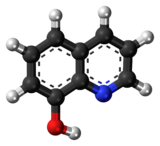8-Hydroxyquinoline
Chemical compound From Wikipedia, the free encyclopedia
8-Hydroxyquinoline (also known as oxine) is an organic compound derived from the heterocycle quinoline. A colorless solid, its conjugate base is a chelating agent, which is used for the quantitative determination of metal ions.
 | |
 | |
 | |
| Names | |
|---|---|
| Preferred IUPAC name
Quinolin-8-ol | |
| Other names
1-Azanaphthalene-8-ol, Fennosan H 30, Hydroxybenzopyridine, Oxybenzopyridine, Oxychinolin, Oxyquinoline, Phenopyridine, Quinophenol, Oxine, 8-Quinolinol | |
| Identifiers | |
3D model (JSmol) |
|
| ChEBI | |
| ChEMBL | |
| ChemSpider | |
| ECHA InfoCard | 100.005.193 |
| KEGG | |
PubChem CID |
|
| UNII | |
CompTox Dashboard (EPA) |
|
| |
| |
| Properties | |
| C9H7NO | |
| Molar mass | 145.16 g/mol |
| Appearance | White crystalline powder |
| Density | 1.034 g/cm3 |
| Melting point | 76 °C (169 °F; 349 K) |
| Boiling point | 276 °C (529 °F; 549 K) |
| Pharmacology | |
| G01AC30 (WHO) A01AB07 (WHO) D08AH03 (WHO) R02AA14 (WHO) | |
| Hazards | |
| GHS labelling: | |
    | |
| Danger | |
| H301, H317, H318, H360D, H410 | |
| P202, P273, P280, P301+P310, P302+P352, P305+P351+P338 | |
| Safety data sheet (SDS) | External MSDS |
Except where otherwise noted, data are given for materials in their standard state (at 25 °C [77 °F], 100 kPa).
| |
In aqueous solution 8-hydroxyquinoline has a pKa value of ca. 9.9[1] It reacts with metal ions, losing the proton and forming 8-hydroxyquinolinato-chelate complexes.

The aluminium complex,[3] is a common component of organic light-emitting diodes (OLEDs). Substituents on the quinoline ring affect the luminescence properties.[4]
In its photo-induced excited-state, 8-hydroxyquinoline converts to zwitterionic isomers, in which the hydrogen atom is transferred from oxygen to nitrogen.[5]
History
8-hydroxyquinoline was first obtained by Hugo Weidel and his student Albert Cobenzl in 1880. They decarboxylated so-called oxycinchoninic acid (from cinchonine) and characterized the resulting compound as melting at about 70°C. They identified that the hydroxy group is on the benzene ring (but not its particular place) and called the compound oxyquinoline and α-quinophenol.[6]
In the following year more chemists found other ways to make the compound. Zdenko Hans Skraup discovered a way to synthesize substituted quinolines from substituted phenols and described three isomers of oxyquinoline, identifying the structure of 8-hydroxyquinoline.[7] Otto Fischer and his student Karl Bedall made the compound from a sulphonic acid independently at about the same time, but misidentified its structure.[8][9]
By 1888 azo dyes were made from the compound.[10]
In the 1920s insoluble chelates of 8-hydroxyquinoline were discovered.[11]
This section needs expansion. You can help by adding to it. (December 2024) |
Bioactivity
The complexes as well as the heterocycle itself exhibit antiseptic, disinfectant, and pesticide properties,[12][13] functioning as a transcription inhibitor.[14] [dubious – discuss] Its solution in alcohol is used in liquid bandages. It once was of interest as an anti-cancer drug.[15]
A thiol analogue, 8-mercaptoquinoline is also known.[16]
The roots of the invasive plant Centaurea diffusa release 8-hydroxyquinoline, which has a negative effect on plants that have not co-evolved with it.[17]
See also
- Nitroxoline (5-nitro-8-hydroxyquinoline), an antiprotozoal drug
- PBT2
- QUPIC
- Ionophore
- Trace metal detection test
References
Wikiwand - on
Seamless Wikipedia browsing. On steroids.
